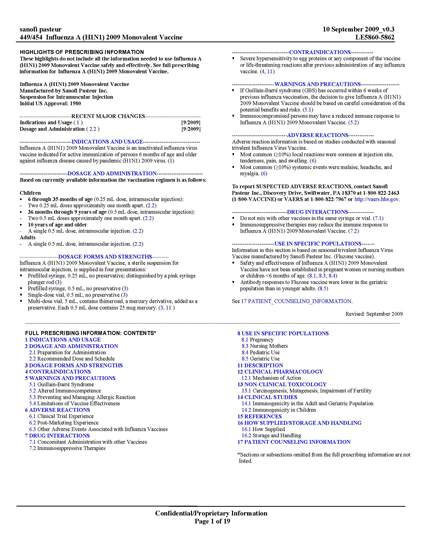449/454 Influenza A (H1N1) 2009 Monovalent Vaccine
- 19 pages
- September 10, 2009
HIGHLIGHTS OF PRESCRIBING INFORMATION
These highlights do not include all the information needed to use Influenza A (H1N1) 2009 Monovalent Vaccine safely and effectively. See full prescribing information for Influenza A (H1N1) 2009 Monovalent Vaccine.
Influenza A (H1N1) 2009 Monovalent Vaccine
Manufactured by Sanofi Pasteur Inc.
Suspension for Intramuscular Injection
Initial US Approval: 1980…
5.1. Guillain-Barré Syndrome
Recurrence of Guillain-Barré syndrome (GBS) has been temporally associated with the administration of influenza vaccine. The decision to give Influenza A (H1N1) 2009 Monovalent Vaccine to individuals who have a prior history of Guillain-Barré syndrome should be based on careful consideration of the potential benefits and risks.
5 .2. Altered Immunocompetence
If Influenza A (H1N1) 2009 Monovalent Vaccine is administered to immunocompromised persons, including those receiving immunosuppressive therapy, the immune response may be diminished.
5.3. Preventing and Managing Allergic Reaction
Appropriate medical treatment and supervision must be available to manage possible anaphylactic reactions following administration of the vaccine.
5.4. Limitations of Vaccine Effectiveness
Vaccination with Influenza A (H1N1) 2009 Monovalent Vaccine may not protect all recipients.
6. ADVERSE REACTIONS
Sanofi Pasteur’s Influenza A (H1N1) 2009 Monovalent Vaccine and seasonal trivalent Influenza Virus Vaccine (Fluzone®) are manufactured by the same process. The following sub-sections summarize safety data from clinical experience with seasonal trivalent inactivated influenza vaccines, including Fluzone vaccine.6.1. Clinical Trial Experience
Adverse event information from clinical trials provides the basis for identifying adverse events that appear to be related to vaccine use and for approximating the rates of these events. However, because clinical trials are conducted under widely varying conditions, adverse event rates observed in the clinical trials of a vaccine cannot be directly compared to rates in the clinical trial of another vaccine, and may not reflect the rates observed in practice.
Adults and Geriatrics
In placebo-controlled studies among adults, the most frequent side effect of vaccination is soreness at the vaccination site (affecting 10%–64% of patients) that lasts <2 days, local pain and swelling. These local reactions typically are mild. Fever, malaise, myalgia, and other systemic symptoms can occur following vaccination and most often affect persons who have had no prior exposure to the influenza virus antigens in the vaccine (e.g., young children). These reactions begin 6–12 hours after vaccination and can persist for 1–2 days. Placebo-controlled trials demonstrate that among older persons and healthy young adults, administration of split-virus influenza vaccine is not associated with higher rates of systemic symptoms (e.g., fever, malaise, myalgia, and headache) when compared with placebo injections. (2)
Children
The 2003-2004 formulation of Fluzone vaccine was studied in 19 children 6 to 23 months of age and in 12 children 24 to 36 months of age, given in 2 doses one month apart. Local reactions and systemic events were solicited for 3 days after each dose. Most local and systemic reactions were mild. The proportions of local and systemic reactions in children were similar to the proportions in adults. No reported local or systemic reaction required a therapeutic intervention other than analgesics. (3)
6.2. Post-Marketing Experience
The following additional events have been reported during post-approval use of Fluzone vaccine. Because these events are reported voluntarily from a population of uncertain size, it is not always possible to reliably estimate their frequency or establish a causal relationship to vaccine exposure.
Blood and Lymphatic System Disorders: Thrombocytopenia, lymphadenopathy
Immune System Disorders: Anaphylaxis, other allergic/hypersensitivity reactions (including urticaria, angioedema)
Nervous System Disorders: GBS, convulsions, myelitis (including encephalomyelitis and transverse myelitis), facial palsy (Bell’s palsy), optic neuritis/neuropathy, brachial neuritis, syncope (shortly after vaccination), dizziness, paresthesia Vascular Disorders: Vasculitis, vasodilation/flushing
Respiratory, Thoracic and Mediastinal Disorders: Dyspnea, pharyngitis, rhinitis
Skin and Subcutaneous Tissue Disorders: Stevens-Johnson syndrome
General Disorders and Administration Site Conditions: Fever, pain, pruritis, asthenia/fatigue, pain in extremities, chest pain
6.3. Other Adverse Events Associated with Influenza Vaccines
Anaphylaxis has been reported after administration of influenza vaccines. Although Influenza A (H1N1) 2009 Monovalent Vaccine contains only a limited quantity of egg protein, this protein can induce immediate hypersensitivity reactions among persons who have severe egg allergy. Allergic reactions include hives, angioedema, allergic asthma, and systemic anaphylaxis. [See Contraindications (4)]
The 1976 swine influenza vaccine was associated with an increased frequency of Guillain-Barré syndrome (GBS). Evidence for a causal relation of GBS with subsequent vaccines prepared from other influenza viruses is unclear. If influenza vaccine does pose a risk, it is probably slightly more than 1 additional case/1 million persons vaccinated. Neurological disorders temporally associated with influenza vaccination such as encephalopathy, optic neuritis/neuropathy, partial facial paralysis, and brachial plexus neuropathy have been reported. Microscopic polyangitis (vasculitis) has been reported temporally associated with influenza vaccination.…
8.
USE IN SPECIFIC POPULATIONS 1
Sanofi Pasteur’s Influenza A (H1N1) 2009 Monovalent Vaccine and seasonal trivalent Influenza Virus Vaccine (Fluzone vaccine) are manufactured by the same process. Available information for Fluzone vaccine is provided in this section.8.1. Pregnancy
Pregnancy Category C: Animal reproduction studies have not been conducted with Influenza A (H1N1) 2009 Monovalent Vaccine or Fluzone vaccine. It is also not known whether these vaccines can cause fetal harm when administered to a pregnant woman or can affect reproduction capacity. Influenza A (H1N1) 2009 Monovalent Vaccine should be given to a pregnant woman only if clearly needed.8.3. Nursing Mothers
It is not known whether Influenza A (H1N1) 2009 Monovalent Vaccine or Fluzone vaccine is excreted in human milk. Because many drugs are excreted in human milk, caution should be exercised when this vaccine is administered to a nursing woman.8.4. Pediatric Use
Safety and effectiveness in pediatric subjects below the age of 6 months have not been established. The immune response and safety of Fluzone vaccine was evaluated in 31 children between the ages of 6-26 months. [See Adverse Reactions (6.1), Clinical Studies (14)]

